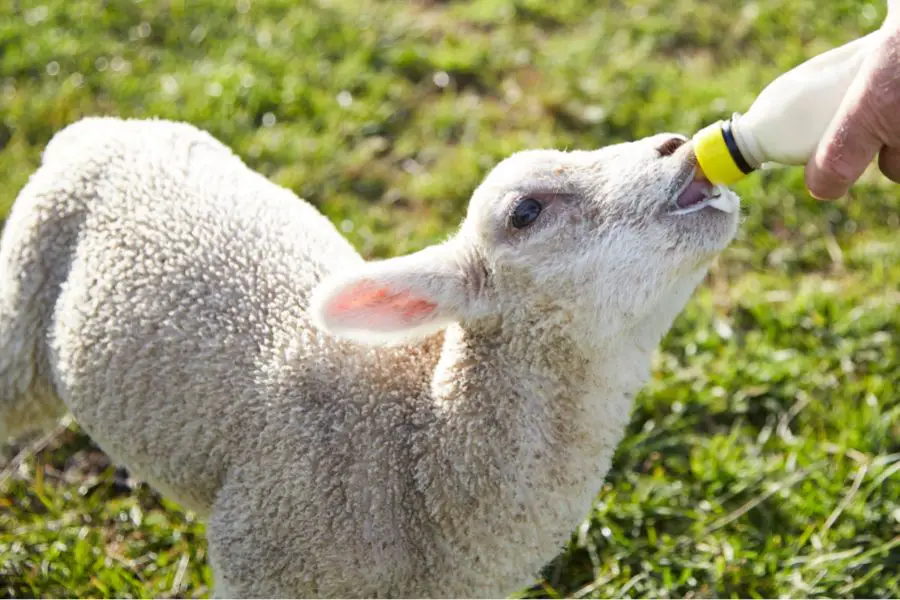Newborn lambs can survive about six hours after birth without drinking milk. This time varies depending on the weather conditions, the difficulty of the birth, and the condition of the lamb.
Generally, lambs that have not drunk milk within six hours of birth have lost too much body heat and are hypothermic. As the lamb's temperature drops, its ability to carry out normal life functions such as digestion reduces. Therefore, a hypothermic lamb cannot absorb the milk and must first be warmed before being fed.
Lambs are born with very little brown fat stores, which generate energy for maintaining body heat. This makes lambs vulnerable to the cold, resulting in hypothermia, a common cause of lamb death. Milk supplies nutrients that the lamb's body uses to keep the body temperature stable.
An older lamb (one to two weeks) may survive up to twenty-four hours without milk but will be in poor condition after this time without food. Dehydration and low body temperature will result, and the lamb will need intensive intervention to survive.
Environmental conditions play a key role in the ability of lambs to survive if access to milk is delayed. Extreme temperatures result in hypothermia, dehydration, or both and will shorten the time available for intervention.
How Soon After Birth A Lamb Must Receive Colostrum?

Antibodies do not pass through the placenta of a ewe to her lambs. The result is that lambs are born with no immunity to diseases or pathogens. Therefore, receiving colostrum is critical for the survival of the lamb.
The lamb's gut does not produce protein-digesting enzymes during the first twenty-four hours after birth. The absence of enzymes allows the colostrum antibodies to be absorbed as whole proteins, so the lamb acquires passive immunity from its mother.
Lambs must, therefore, receive colostrum within the first twenty-four hours to acquire immunity. Realistically though, lambs should receive colostrum as soon after birth as possible. Most farmers adhere to the guidelines that the ideal time for colostrum intake is the first three to four hours after birth.
Lambs should be fed once within the first three to four hours and twice within the first six hours. Healthy lambs with minimal birth stress usually feed within the first fifteen to thirty minutes.
Complicated births, low birth weight lambs, and multiple lambs' births can result in weaker newborns, which need to be monitored carefully to ensure they receive adequate colostrum.
Farmers should be prepared with a supply of colostrum before lambing begins, as there is little time to access it if a problem occurs. Colostrum from other ewes, cow colostrum, or artificial colostrum may be used for orphaned or rejected lambs.
Experienced farmers and scientists suggest that if a lamb has not received colostrum, it is worth trying for up to forty-eight hours after birth. This is because the protein-digesting enzymes will still be reduced in this period, and there is a possibility that some antibodies may still be absorbed.
Do Older Lambs Need Milk?
Dairy lambs are weaned early, with some being weaned at thirty to thirty-five days. Most dairy farmers wean their lambs at eight weeks. By that time, the lamb has had good nutrition from the ewe, and the farmer begins milking the ewe.
Meat and wool lambs are usually weaned at four to six months. They can go without milk at this age and will have no nutritional deficiencies if their grazing is supplemented with concentrates. In rich pastures, supplementation may not be necessary.
Hard food is introduced to the lambs two weeks before weaning. Lambs of one month have teeth and eat grass and sheep feed if provided. They can survive from this age without any milk if adequate food is given.
Sheep naturally wean their lambs at four to six months, depending on the breed, the ewe's condition, and the climate. Lambs of this age do not need milk. They can survive on pasture. Some farmers may choose to continue providing milk to their lambs for a period of time after weaning, but this is not necessary for the lambs' survival.
Lambs between six to twelve months are weaned, even in the wild, and do not need milk.
Reasons a Lamb May Not Get Milk
Lambs may not have access to milk for various reasons.
- The ewe may reject the lamb.
- Multiple births mean less colostrum for each lamb, and a weaker sibling may be pushed aside.
- A ewe in poor condition may not have sufficient milk.
- The ewe may die, leaving the lamb as an orphan.
- Low birth weight or difficult births result in weak lambs that struggle to nurse.
- A ewe should have her wool cut around her udder before lambing. Long wool may prevent the lamb from accessing the teats. Lambs may become confused and suck on the wool instead of the teats.
- Mastitis prevents a lamb from nursing as the ewe is sore and moves away.
It's important to note that lambs have different nutritional needs at different stages of their lives, so it's essential to consult with a veterinarian or animal nutrition expert to ensure that they are receiving an appropriate diet for their age and health status.
